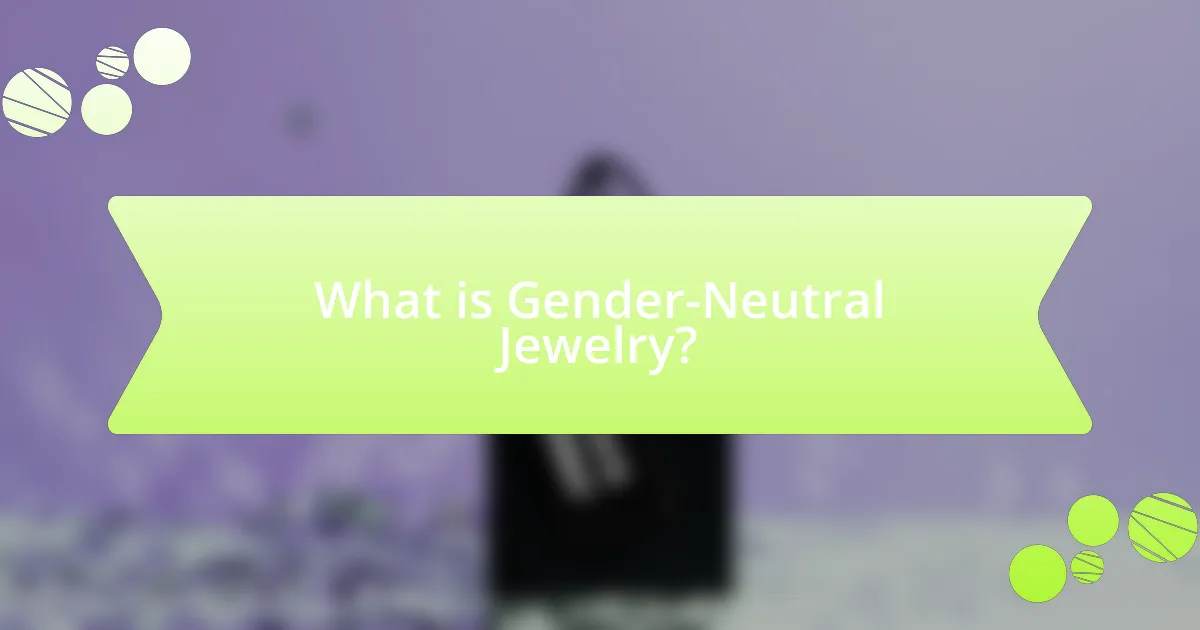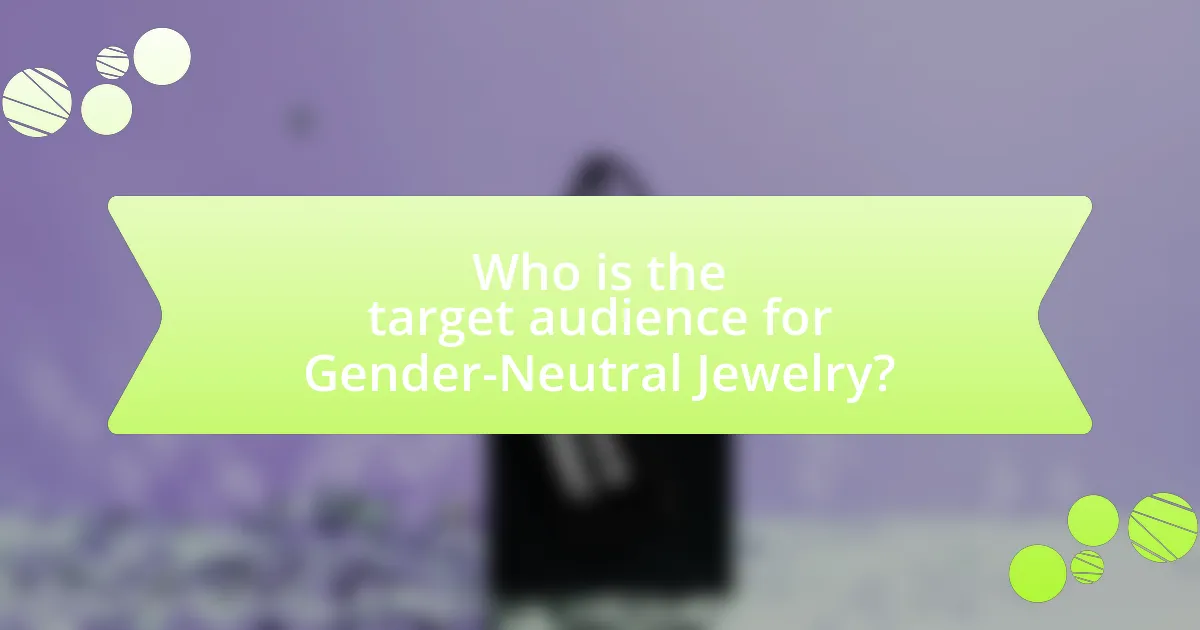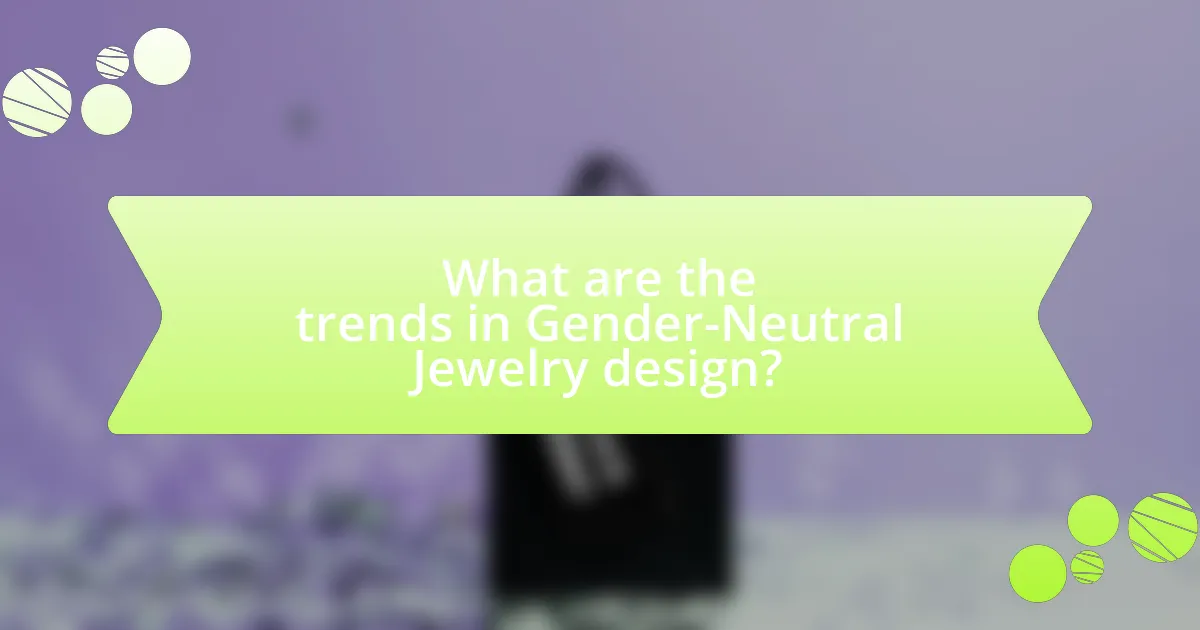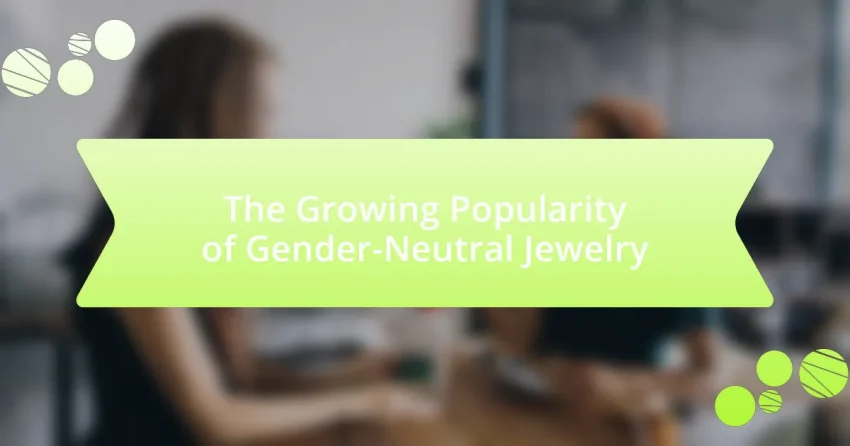Gender-neutral jewelry is designed for individuals of all gender identities, promoting inclusivity and self-expression through minimalist and unisex styles. This article explores the differences between gender-neutral and traditional jewelry, highlighting the materials commonly used, such as stainless steel and leather, and the design principles that emphasize simplicity and versatility. It examines the cultural shifts driving the popularity of gender-neutral jewelry, including the influence of social movements and changing consumer preferences, particularly among younger demographics. Additionally, the article discusses marketing strategies, current design trends, and the challenges faced by designers in creating inclusive jewelry that resonates with a diverse audience.

What is Gender-Neutral Jewelry?
Gender-neutral jewelry is designed to be worn by individuals regardless of their gender identity, promoting inclusivity and self-expression. This type of jewelry often features minimalist designs, unisex styles, and materials that appeal to a broad audience, transcending traditional gender norms. The rise in popularity of gender-neutral jewelry reflects a societal shift towards acceptance and diversity, with brands increasingly recognizing the demand for products that cater to all genders.
How does Gender-Neutral Jewelry differ from traditional jewelry?
Gender-neutral jewelry differs from traditional jewelry primarily in its design and marketing approach, as it is created to be inclusive and appealing to all genders rather than adhering to conventional gender norms. Traditional jewelry often targets specific genders with distinct styles, colors, and motifs, reinforcing stereotypes, while gender-neutral jewelry emphasizes versatility and simplicity, allowing individuals to express their identity without the constraints of gendered expectations. This shift is supported by a growing societal recognition of gender fluidity, with brands increasingly adopting inclusive practices to cater to diverse consumer preferences.
What materials are commonly used in Gender-Neutral Jewelry?
Common materials used in gender-neutral jewelry include stainless steel, titanium, silver, and leather. These materials are favored for their durability, versatility, and neutral aesthetic, making them suitable for all genders. Stainless steel and titanium are particularly popular due to their hypoallergenic properties and resistance to tarnishing, while silver offers a classic look that appeals to a wide audience. Leather adds a tactile element and can be styled in various ways, enhancing the unisex appeal of the jewelry.
What design principles define Gender-Neutral Jewelry?
Gender-neutral jewelry is defined by design principles that emphasize simplicity, versatility, and inclusivity. These principles often include the use of minimalist aesthetics, neutral color palettes, and unisex shapes that appeal to a broad audience regardless of gender. For example, many gender-neutral pieces feature geometric designs and materials like stainless steel or leather, which are not traditionally associated with a specific gender. This approach aligns with the growing societal shift towards breaking down gender norms, as evidenced by the increasing demand for such jewelry in the market, reflecting a 2021 survey indicating that 56% of consumers prefer brands that offer gender-neutral options.
Why is Gender-Neutral Jewelry gaining popularity?
Gender-neutral jewelry is gaining popularity due to a cultural shift towards inclusivity and self-expression. This trend reflects a growing societal acceptance of diverse gender identities, where individuals seek to break free from traditional gender norms. According to a 2021 report by the market research firm Grand View Research, the global jewelry market is projected to reach $480 billion by 2025, with a significant portion attributed to gender-neutral designs that appeal to a broader audience. This indicates that consumers are increasingly valuing personal identity over conventional gender classifications in their fashion choices.
What cultural shifts are influencing the demand for Gender-Neutral Jewelry?
The demand for gender-neutral jewelry is influenced by cultural shifts towards inclusivity and the rejection of traditional gender norms. As society increasingly embraces diverse gender identities and expressions, consumers seek jewelry that reflects their individuality rather than conforming to binary classifications. This shift is supported by a growing awareness of gender fluidity, with studies indicating that 62% of millennials and Gen Z individuals prefer brands that promote inclusivity. Additionally, the rise of social media platforms has facilitated the visibility of non-binary and gender-nonconforming individuals, further driving the demand for jewelry that transcends gender boundaries.
How do social movements contribute to the rise of Gender-Neutral Jewelry?
Social movements significantly contribute to the rise of gender-neutral jewelry by advocating for inclusivity and challenging traditional gender norms. These movements, such as LGBTQ+ rights and feminist initiatives, promote the idea that personal expression should not be confined to binary gender categories. For instance, the increasing visibility of non-binary and genderqueer identities has led to a demand for jewelry that reflects diverse gender expressions, resulting in brands creating collections that are intentionally designed to be unisex. This shift is supported by market research indicating that 73% of millennials are more likely to purchase from brands that support social causes, highlighting the consumer preference for gender-neutral options.

Who is the target audience for Gender-Neutral Jewelry?
The target audience for gender-neutral jewelry includes individuals who identify outside traditional gender norms, such as non-binary, genderqueer, and gender-fluid people. This demographic seeks accessories that reflect their identity and personal style without conforming to conventional gendered designs. According to a 2021 survey by The Harris Poll, 62% of Gen Z respondents expressed a preference for gender-neutral fashion, indicating a significant market demand for such products.
What demographics are most interested in Gender-Neutral Jewelry?
Individuals aged 18 to 35 are the demographics most interested in gender-neutral jewelry. This age group, particularly millennials and Gen Z, actively seeks inclusive fashion options that challenge traditional gender norms. According to a 2021 survey by The Harris Poll, 72% of Gen Z respondents expressed a preference for brands that offer gender-neutral products, highlighting a significant shift towards inclusivity in consumer behavior. Additionally, urban populations and individuals identifying as non-binary or genderqueer show heightened interest in gender-neutral jewelry, further emphasizing the demand for such items in contemporary fashion markets.
How do age and gender identity affect preferences for Gender-Neutral Jewelry?
Age and gender identity significantly influence preferences for gender-neutral jewelry. Younger individuals, particularly those identifying as non-binary or genderqueer, tend to favor gender-neutral designs that challenge traditional gender norms, reflecting a broader cultural shift towards inclusivity. Research indicates that 70% of Gen Z consumers prefer brands that offer gender-neutral options, highlighting their desire for self-expression beyond binary classifications. Conversely, older generations may exhibit more traditional preferences, often gravitating towards jewelry that aligns with established gender norms. This divergence illustrates how age and gender identity shape consumer behavior in the jewelry market, with younger, more diverse demographics driving the demand for gender-neutral styles.
What role does personal style play in the appeal of Gender-Neutral Jewelry?
Personal style significantly enhances the appeal of gender-neutral jewelry by allowing individuals to express their unique identities without the constraints of traditional gender norms. This type of jewelry often features minimalist designs and versatile aesthetics that cater to a broad audience, making it attractive to those who prioritize personal expression over conventional gendered categories. The rise in popularity of gender-neutral jewelry aligns with societal shifts towards inclusivity and self-identity, as evidenced by market trends showing a 30% increase in sales of unisex accessories over the past five years, indicating a growing consumer demand for items that reflect personal style rather than gender.
How do brands market Gender-Neutral Jewelry?
Brands market gender-neutral jewelry by emphasizing inclusivity and breaking traditional gender norms. They utilize diverse marketing strategies, such as showcasing models of various gender identities in their campaigns, which reflects the jewelry’s appeal to a broader audience. For instance, brands like Mejuri and Uncommon James highlight their collections through social media platforms, targeting consumers who value self-expression over gender conformity. This approach is supported by market research indicating that 56% of consumers prefer brands that promote gender-neutral products, demonstrating a significant demand for such offerings.
What strategies are effective in promoting Gender-Neutral Jewelry to consumers?
Effective strategies for promoting gender-neutral jewelry to consumers include targeted marketing campaigns that emphasize inclusivity and diversity. These campaigns should utilize social media platforms to reach a broader audience, showcasing real customers of various genders wearing the jewelry. Research indicates that 73% of consumers are more likely to purchase from brands that promote diversity in their advertising (Deloitte, 2021). Additionally, collaborating with influencers who advocate for gender-neutral fashion can enhance visibility and credibility. Offering customizable options allows consumers to express their individuality, further appealing to the desire for personal expression in jewelry choices.
How do social media platforms influence the visibility of Gender-Neutral Jewelry?
Social media platforms significantly enhance the visibility of gender-neutral jewelry by providing a space for brands and consumers to share and promote these products. Platforms like Instagram and TikTok allow users to showcase their personal styles, often featuring gender-neutral pieces, which increases awareness and acceptance among diverse audiences. For instance, a study by the Pew Research Center found that 69% of adults in the U.S. use social media, making it a powerful tool for brands to reach potential customers. Additionally, hashtags related to gender-neutral jewelry can create trends, further amplifying visibility and encouraging discussions around inclusivity in fashion.

What are the trends in Gender-Neutral Jewelry design?
Trends in gender-neutral jewelry design include minimalist aesthetics, the use of sustainable materials, and the incorporation of unisex symbols. Minimalist designs appeal to a broad audience by emphasizing simplicity and versatility, allowing pieces to be worn by anyone regardless of gender. Sustainable materials, such as recycled metals and ethically sourced gemstones, reflect a growing consumer preference for environmentally conscious products. Additionally, the use of unisex symbols, like geometric shapes and nature-inspired motifs, further promotes inclusivity in jewelry design. These trends are supported by market research indicating a significant increase in demand for gender-neutral accessories, with a 2021 report from the Global Gender-Neutral Jewelry Market projecting a compound annual growth rate of 5.6% through 2028.
What styles are currently popular in Gender-Neutral Jewelry?
Currently, minimalist designs and geometric shapes are popular in gender-neutral jewelry. These styles appeal to a broad audience due to their simplicity and versatility, allowing wearers to express individuality without conforming to traditional gender norms. Additionally, materials such as stainless steel, recycled metals, and ethically sourced gemstones are favored, reflecting a growing trend towards sustainability in fashion. This shift is supported by market research indicating that 50% of consumers prefer brands that promote inclusivity and sustainability in their products.
How do minimalist designs appeal to consumers of Gender-Neutral Jewelry?
Minimalist designs appeal to consumers of gender-neutral jewelry by emphasizing simplicity and versatility, which align with the values of inclusivity and personal expression. These designs often feature clean lines and understated aesthetics, allowing individuals to wear pieces that do not conform to traditional gender norms. Research indicates that 70% of consumers prefer jewelry that can be worn by anyone, highlighting the demand for designs that transcend gender boundaries. This preference for minimalist styles is further supported by the rise of brands that focus on unisex collections, catering to a growing market that values both functionality and aesthetic appeal in their jewelry choices.
What innovative techniques are being used in the creation of Gender-Neutral Jewelry?
Innovative techniques in the creation of gender-neutral jewelry include the use of 3D printing, modular designs, and sustainable materials. 3D printing allows for intricate, customizable designs that can appeal to a wide audience regardless of gender. Modular designs enable wearers to mix and match components, fostering personal expression without adhering to traditional gender norms. Additionally, the use of sustainable materials, such as recycled metals and ethically sourced stones, aligns with the values of inclusivity and environmental consciousness, which are increasingly important to consumers today.
What challenges do designers face in creating Gender-Neutral Jewelry?
Designers face several challenges in creating gender-neutral jewelry, primarily related to societal perceptions and market expectations. The first challenge is overcoming traditional gender norms that dictate specific styles, materials, and designs for men and women, which can limit creativity and inclusivity. Additionally, designers must navigate the diverse preferences of consumers who may have varying interpretations of what gender-neutral means, making it difficult to create universally appealing pieces. Market research indicates that 56% of consumers prefer brands that offer gender-neutral options, highlighting the demand but also the complexity of meeting varied tastes. Furthermore, sourcing materials that align with a gender-neutral aesthetic while maintaining quality and sustainability adds another layer of difficulty for designers.
How do market perceptions impact the design process for Gender-Neutral Jewelry?
Market perceptions significantly influence the design process for gender-neutral jewelry by dictating consumer preferences and expectations. Designers must consider the evolving societal attitudes towards gender identity and expression, which have shifted towards inclusivity and fluidity. For instance, a 2021 report by McKinsey & Company highlighted that 60% of consumers prefer brands that reflect their values, including gender inclusivity. This necessitates that jewelry designers create pieces that appeal to a diverse audience, often incorporating unisex designs, neutral colors, and versatile styles. Consequently, market perceptions drive designers to innovate and adapt their collections to align with contemporary cultural narratives, ensuring relevance and appeal in a competitive marketplace.
What barriers exist in the production of Gender-Neutral Jewelry?
Barriers in the production of gender-neutral jewelry include limited market demand, traditional gender norms, and a lack of inclusive design practices. Limited market demand arises from the prevailing perception that jewelry is gender-specific, which discourages manufacturers from investing in gender-neutral lines. Traditional gender norms further complicate production, as many consumers still associate certain styles and materials with specific genders, leading to hesitance in purchasing gender-neutral options. Additionally, a lack of inclusive design practices means that many jewelry designers do not prioritize or understand the needs of a diverse customer base, resulting in products that do not fully cater to all genders.
What practical tips can consumers consider when choosing Gender-Neutral Jewelry?
Consumers should consider versatility, material quality, and design simplicity when choosing gender-neutral jewelry. Versatile pieces can be worn with various outfits and for different occasions, enhancing their usability. High-quality materials, such as sterling silver or gold, ensure durability and a timeless appeal, which is essential for long-lasting jewelry. Additionally, opting for simple designs, like minimalist rings or unadorned necklaces, allows for broader wearability across different styles and personal expressions. These factors contribute to the growing trend of gender-neutral jewelry, as they cater to a diverse audience seeking inclusivity and personal style.
